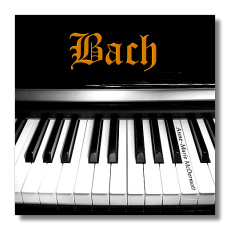
The Internet's Premier Classical Music Source
Related Links
- J.S. Bach Reviews
- Latest Reviews
- More Reviews
-
By Composer
-
Collections
DVD & Blu-ray
Books
Concert Reviews
Articles/Interviews
Software
Audio
Search Amazon
Recommended Links
Site News
 CD Review
CD Review
Johann Sebastian Bach

Works for Solo Keyboard
- Partita #1 in B Flat Major, BWV 825
- Partita #2 in C minor, BWV 826
- English Suite #2 in A minor, BWV 807
- English Suite #3 in G minor, BWV 808
Anne-Marie McDermott, piano
Recorded St. George's, Brandon Hill, Bristol, U.K.
NSS Music 4 63:26
Comparisons:
Partitas - Argerich/DG (no. 2), Gould/Sony, Rangell/Dorian, Rubsam/Naxos, Tureck/Philips
English Suites - Argerich/DG (no. 2), Gould/Sony, Perahia/Sony, Pires/DG (no. 3), Rubsam/Naxos
Except for one reservation, Anne-Marie McDermott's new Bach disc is a total pleasure. My previous exposure to her artistry was a Prokofieff disc on the Arabesque label, and I am now convinced that McDermott is a major pianist with a wonderful career ahead of her. McDermott has won numerous piano competitions and often performs as a soloist at the major recital halls in the United States and Europe. She began playing the piano at the age of five, and seven years later performed the Mendelssohn Concerto in G minor at Carnegie Hall. Her primary studies were at the Manhattan School of Music with Constance Keene and John Browning. McDermott's "breakthrough" was her 1997 debut with the New York Philharmonic, and the following years have seen her reputation rise greatly to the point where she is now on the cusp of major stardom.
Although quite a simplification, we can get a fine idea of her Bach artistry by looking at her playing of the composer's fast/powerful/exciting movements on the disc and how she approaches the movements requiring tenderness/nostalgia/poignancy. Concerning the exciting movements, there are a host of them: English Suite #2 (Prelude, Courante, Bourrée I & II, Gigue), English Suite #3 (Prelude, Courante, Gigue), Partita #1 (Allemande, Courante, Gigue), and Partita #2 (Courante, Rondeaux, Capriccio). For review purposes only, I've been playing these movementsone after another and marveling at McDermott's technical prowess with a reserve of power second to none and galloping rhythms that are thrilling to listen to. Essentially, she lets her "flying fingers" do all thetalking yet never allows the music's lyricism to elude her. If you cravepropulsion, pin-point articulation and break-neck speeds in thesemovements, McDermott is an electrifying guide.
In Bach's more reflective music, McDermott is equally successful. She fully conveys the nobility, sadness, despair, tenderness, and fragile nature of the human condition while always maintaining a mesmerizing rhythmic pulse and perfect articulation. Her readings are often of a dream-like state, and I am unable to resist McDermott's call. Overall, I find her to have all the gifts to become one of the great Bach pianistsof our time. Except….
It's now time to delve into the one reservation that I referred to inthe opening sentence of the review. It involves Bach's repeats in that most of the movements are in AABB form. Performers have numerous ways to approach these repeats: not play them at all, play them exactly as in the initial recitation, or vary them based on changes in articulation, tempo, pacing, dynamics, embellishments such as trills, etc. McDermott observes all the repeats and varies them primarily through dynamic contrast. This reviewer thinks highly of varying repeats but feels thatrelatively subtle changes are more likely to enhance the music and thatdramatic changes can often call attention to themselves, sound contrived, and damage one's immersion in the music.
Unfortunately, there is nothing subtle about McDermott's approach tovarying the repeats. When the theme is initially presented softly, itsrepeat is usually in the forte range or stronger; the opposite sudden differences happen when the theme is first presented as forte. These are huge dynamic contrasts, and I find them jarring to the listening experience. Put another way, McDermott has me entirely encased in Bach's sound world but then takes me back to Earth with a big thud. I should report that a fellow Bach enthusiast whom I respect very much has no problem at all with McDermott's contrasts, so it would be a good idea for readers to sample the disc and reach their own conclusions about what I consider the "sforzando" aspect of McDermott's performances. I do want to emphasize that the strong dynamic contrasts do not ruin the music but take it down a notch or two from a very exalted level. Still, McDermott's Bach disc easily holds its own with the exceptional recordings noted in the heading.
Almost forgot to offer a few words about the NSS music label. It was founded in the Fall of 2005 by the well-known violinist Nadja Salerno-Sonnenberg and already has a few recordings to its credit. Salerno-Sonnenberg sees her new label as a haven for performing artists, and I consider it quite a coup for her to have McDermott as one of the label's artists. With all the new labels started by performers and symphony orchestras, the retrenchment of the once-major classical labels is not hard to abide.
Don's Conclusions: Anne-Marie McDermott gives us a blend of dazzling virtuosity and deep emotional satisfaction that would be difficult to match. Her soundstage is also impressive with a rich tone, deep bass, and excellent separation of musical lines. Even with the reservation I have noted concerning her repeats, I am proud to have this excellent recording and intend to play it often in the future.
Copyright © 2006, Don Satz




















